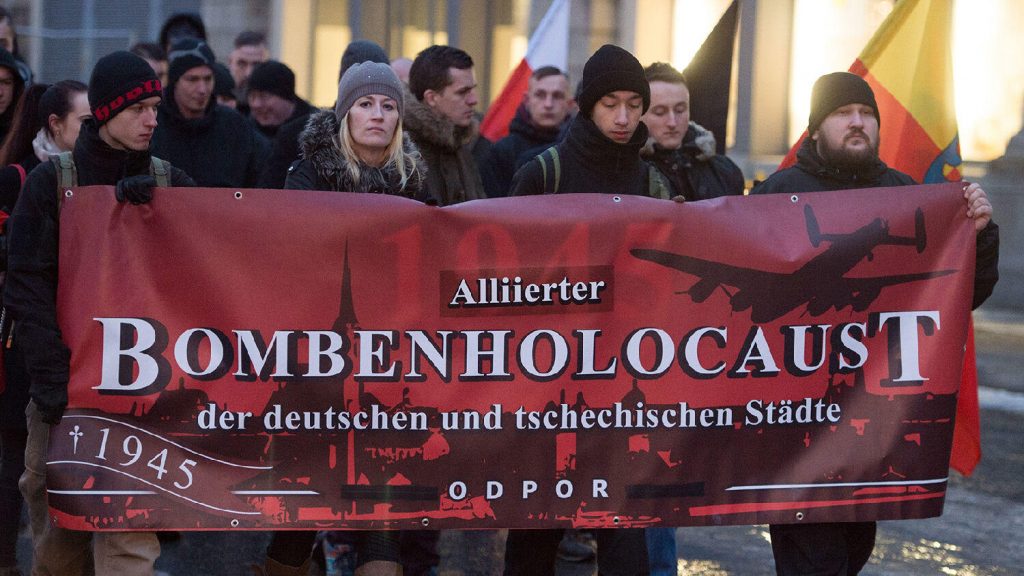Society of East-German Heritage
Ostdeutscher Kulturverband
We remember the Massacre of Dresden
Dear Friends,
what was written last year will also have to suffice this year. The organizer of the past 20 years of Dresden Commemorations is feeling his age, having just turned 90 and missing his former energy. The remembrance will therefore be only found in the internet. Please accept the repetition of last year’s letter. Yes, there are all kinds of reminders of ‘‘man’s inhumanity to man’’ repeated time and again by our media, often going back as far as our own history but never about what happened to us. Thus the accompanying video, Blitz on Dresden, should remind us again of just one instance of what occurred, namely of those fateful days between February 13th and 15th of the year 1945 in Dresden. The film is surprisingly free from propaganda and a true documentary. It not only shows the bombardment of Dresden but also that of Cologne, Hamburg and Berlin. There are also interviews of survivors and participants in those events.
As stated before, we are not only remembering the fate of Dresden but also that of countless other German cities during World War II. And here are some facts: There was an agreement between European nations in 1907 in Den Hague which demanded that in war times civilian populations should be protected. This agreement was shamefully disregarded by those who thought that the mass murder of civilians could bring an early end to the war. In the 54-minute documentary we are told by a German witness that it was the Germans who started the bombing terror. Against this stands the statement of the undersecretary of the British air force, J. M. Spaight who said that “we started this type of warfare before Germany thought to do it against England”. And indeed, the first British air attack was directed against the cities of Wilhelmshaven and Cuxhaven on September 5th, 1939 while the first German counter measure on London took place on September 7, 1940. Winston Churchill decided on the bombardment of German cities the day after he became the British premier, which was on May 11th 1940. On the 12th of May bombs were dropped on civilian living quarters of Mönchengladbach and Aachen. It continued with Düsseldorf on May 13th, with Eschweiler, on May 15th Hamburg, on May 16th... On the 24th of June 1940 Berlin saw its first bombardment.
The accompanying movie starts with the unveiling in London of the statue of Arthur Harris, the chief of “Bomber Command” by the Queen mother, in May of 1994. It is surprising to see British people demonstrating against this ceremony with signs like “People of Dresden forgive us”. Of interest should also be the statement at the beginning of the movie that speaks of 600,000 victims. Well, it echoes Churchill’s pronouncement that he wants to “baste” the 600,000 refugees that had crowded into Dresden from the East, fleeing the advancement of the Soviet army. That number of Dresden victims has shown up in various publications but was gradually reduced – until on February 13th of 2014 it was determined by a German historical commission that the number of victims was only 25,000. This naturally has upset German survivors. It is considered a strange phenomenon that the German government tends to diminish the number of German victims but showing great empathy with those in the rest of the world. What is most disturbing for us, that have witnessed horrible atrocities committed against our people and those that have been expelled from our ancestral homeland of East Germany, is the fact, that young people in Dresden have displayed signs with the words “Do it again Bomber Harris” and have organized “Antifa” groups to shout down those who try to commemorate the Dresden atrocity peacefully.
An interview is also documented with Group Captain Ken Bachelor, a member of Arthur Harris’ “Bomber Command”. He explains that it was due to his efforts that the statue was erected. He says that the bombing of the civilians was justified in order “to free the Germans from the Nazi-Regime”. The truth is, however, that it strengthened the people’s resolve to carry on with the war. He also states that Hitler had said that he wanted to kill 20million people, at 10,000 a day. However, there is absolutely no truth to this and it is not recorded in any book on World War II.
The film finally shows the efforts of the people of Dresden to rebuild their city that had been called “the Florence on the river Elbe”, the crowning achievement of which was the resurrection of the “Church of our Lady”, the “Frauenkirche”. The controversy continues: Was the firebombing of Dresden a crime against humanity? We certainly think so.
Christian Jürgen Klein


